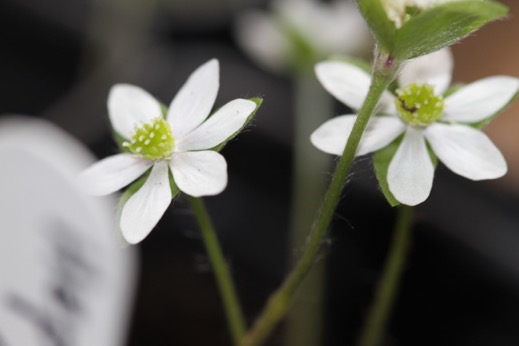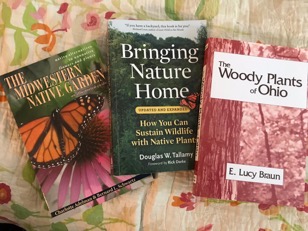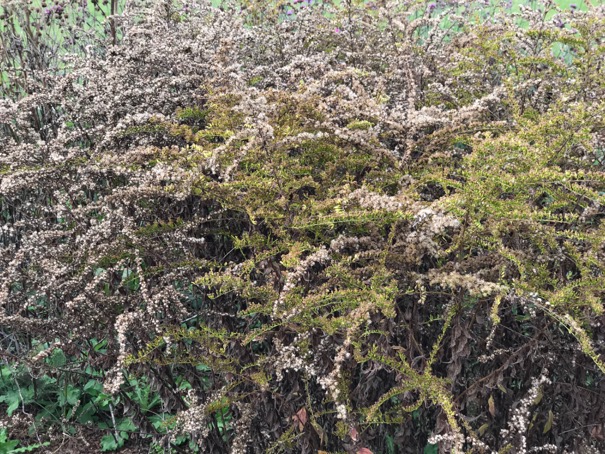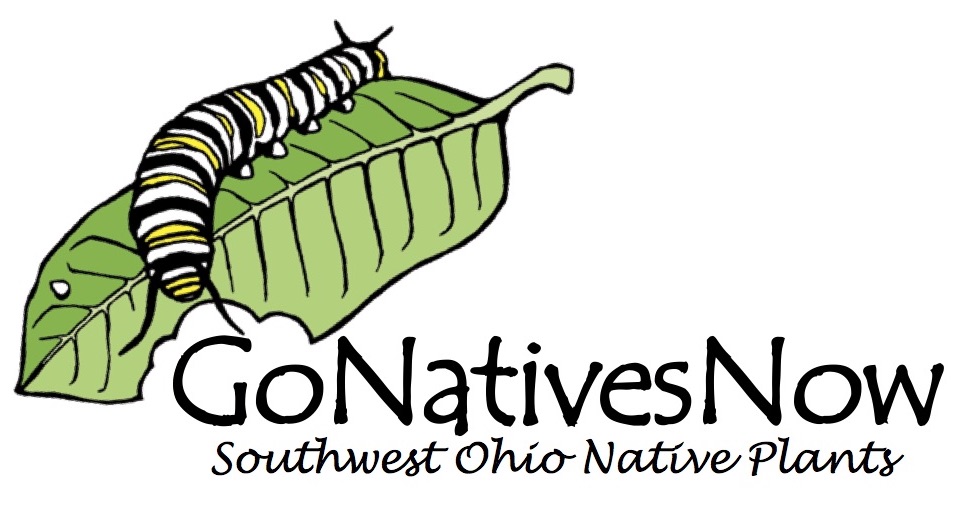Planting a Butterfly Garden
04/05/18 11:02 AM
On Apr 4, 2018, at 9:08 PM, Susan Alverson wrote:
Your Name Susan Alverson
Subject Follow Up
Message I emailed a few days ago (see copy below) but have not had a response and wanted to follow up:
Hi. I came across your site after a search for information about planting a butterfly garden. I live nearby in Liberty Township. We had to do some grading to our yard, which left me with a small, bare earth space that I’m claiming for my garden, so I’m starting from scratch.
The space is about 14’ by 8’ and is pretty much full sun all day, with a little bit of shade from a maple tree. I want to plant a cut-flower garden, with a focus on native flowers that will attract butterflies and hummingbirds. I do not want anything invasive, since I have just a small area to work in.
I know I need milkweed. Would you recommend anything else specifically for a plot that size?
I see that you’re open by appointment. Can you tell me more about that? What is a good time of year to begin buying seeds and/or plants—when do you start selling, in other words?
Thanks for your help!
Susan
Here is my answer
hello Susan,
This is the first message I have received. I am happy to advise you on your new native flower garden. Thanks for sending me some information on your bed. It will be difficult to plant under a maple tree since it generates many roots near the surface. Beyond the edge of its canopy will be fine. GoNativesNow has many plants that would be appropriate for your space. Have you filled out or looked over the questionnaire on the website? It will help you with conditions.
Prairie plants will provide you with lots of flowers for the critters to enjoy and you to make bouquets. I am open any time by appointment. Right now I have spring blooming wildflowers for sale. These grow under trees and bloom before the trees get their leaves. I have many plants in pots that I planted last season. Since it’s been cold, they are not growing yet for the most part. I am in the process of planting my first year natives now. They will be up soon, but very small their first year. (First year sleep, second year creep, third year leap!)
If you start with mature plants, your natives garden will be able to flower sooner. Generally, it takes most natives (perennials) three years to flower. There are exceptions, like coneflower (echinacea purpurea). I also have some annuals to enjoy the first couple years. I recommend that you plant in drifts, the more plants in the group the better, at least three plants, 12-15 is better. Then, make sure you plant ground cover plants (like sedges, sedum, violets) around the bigger/taller plants.
Keep in mind most prairie plants are taller plants. Many flower at eye height (yay, no leaning over to see these flowers!). Many of our native prairie plants are yellow - there are many to choose from and they are lovely. Picture yellows with bursts of purple, pink, and red. Also, I hope you consider some grasses. I have big and small to offer.
I can help you draw out your garden. Get some graph paper. Make a shape that is 14’x8’. I recommend a rounded-oval-beanlike shape. Make sure you make curving paths through it so you can tend it and walk through to enjoy it. Nature abhors straight lines (so do I).
You are lucky to start from scratch. I would cover your entire area with 3-4 inches organic compost, place pots according to your plan, stand back and make sure it’s pleasing. Then plant down through the compost. Water well. Plants will need water the first few months to get established but not after that. Be sure to take lots of pictures as you go.
Would you like a list of plants to consider? If you can take pictures of the spots I can help with suggested plants.
Sue
GoNativesNow
Your Name Susan Alverson
Subject Follow Up
Message I emailed a few days ago (see copy below) but have not had a response and wanted to follow up:
Hi. I came across your site after a search for information about planting a butterfly garden. I live nearby in Liberty Township. We had to do some grading to our yard, which left me with a small, bare earth space that I’m claiming for my garden, so I’m starting from scratch.
The space is about 14’ by 8’ and is pretty much full sun all day, with a little bit of shade from a maple tree. I want to plant a cut-flower garden, with a focus on native flowers that will attract butterflies and hummingbirds. I do not want anything invasive, since I have just a small area to work in.
I know I need milkweed. Would you recommend anything else specifically for a plot that size?
I see that you’re open by appointment. Can you tell me more about that? What is a good time of year to begin buying seeds and/or plants—when do you start selling, in other words?
Thanks for your help!
Susan
Here is my answer
hello Susan,
This is the first message I have received. I am happy to advise you on your new native flower garden. Thanks for sending me some information on your bed. It will be difficult to plant under a maple tree since it generates many roots near the surface. Beyond the edge of its canopy will be fine. GoNativesNow has many plants that would be appropriate for your space. Have you filled out or looked over the questionnaire on the website? It will help you with conditions.
Prairie plants will provide you with lots of flowers for the critters to enjoy and you to make bouquets. I am open any time by appointment. Right now I have spring blooming wildflowers for sale. These grow under trees and bloom before the trees get their leaves. I have many plants in pots that I planted last season. Since it’s been cold, they are not growing yet for the most part. I am in the process of planting my first year natives now. They will be up soon, but very small their first year. (First year sleep, second year creep, third year leap!)
If you start with mature plants, your natives garden will be able to flower sooner. Generally, it takes most natives (perennials) three years to flower. There are exceptions, like coneflower (echinacea purpurea). I also have some annuals to enjoy the first couple years. I recommend that you plant in drifts, the more plants in the group the better, at least three plants, 12-15 is better. Then, make sure you plant ground cover plants (like sedges, sedum, violets) around the bigger/taller plants.
Keep in mind most prairie plants are taller plants. Many flower at eye height (yay, no leaning over to see these flowers!). Many of our native prairie plants are yellow - there are many to choose from and they are lovely. Picture yellows with bursts of purple, pink, and red. Also, I hope you consider some grasses. I have big and small to offer.
I can help you draw out your garden. Get some graph paper. Make a shape that is 14’x8’. I recommend a rounded-oval-beanlike shape. Make sure you make curving paths through it so you can tend it and walk through to enjoy it. Nature abhors straight lines (so do I).
You are lucky to start from scratch. I would cover your entire area with 3-4 inches organic compost, place pots according to your plan, stand back and make sure it’s pleasing. Then plant down through the compost. Water well. Plants will need water the first few months to get established but not after that. Be sure to take lots of pictures as you go.
Would you like a list of plants to consider? If you can take pictures of the spots I can help with suggested plants.
Sue
GoNativesNow
Popular Spring Blooming Natives
03/21/18 02:23 PM
Happy Spring! Although it's snowy today, we're thinking about blooming flowers. GoNativesNow has gotten requests in the past for spring blooming natives. We have them and they are beautiful! Contact us as soon as possible for the best selection. Natives available include:

- Dutchman's breeches, Dicentra cucullaria
- Grand trillium, Trillium grandiflora
- Spring beauties, Claytonia virginica
- Wild ginger, Asarum canadense
- May apple, Podophyllum peltatum
- Hepatica, sharp-toothed, Hepatica acutiloba
- Bloodroot, Sanguinaria canadensis
- Jack-in-the-pulpet, Arisaema triphullum
- Rattlesnake plantain orchid, Goodyear pubescens
- Native pachysandra, Pachysandra procumbent
- Wood/celandine poppy, Stylophorum diphullum
- Yellow trout lily Erythronium americium

Plant the Right Tree for Your Soil
02/16/18 11:21 AM
OK, anybody who knows me knows that I love trees. I have favorite trees wherever I go. If you don't have any trees in your yard, plant one.
First figure out what kind of soil you have. Go to the US Soil Survey website, go to your property, and study the charts. Use this uTube video created by Solomon Gamboa to navigate the website.
Basic Web Soil Survey Guide
Next use this spreadsheet that lists what trees grow best in what soil conditions.
Tree-Soil Spreadsheet
This is useful for anybody (yards, private property or parks) planting trees in our area. Two steps: you use/study the Soil survey data first, then this spreadsheet to find tree species that will grow best in the soil you have.
Why would you do this? You’re looking very long term with trees. You want good conditions for trees down the road for decades, centuries even. With trees, it’s very difficult to change your mind and move them, especially after they get established. You have to kill them and start over. Bad news. It’s difficult to amend the soil and change it to make the tree happy. It’s better to start with the right trees for the soil you have.
First figure out what kind of soil you have. Go to the US Soil Survey website, go to your property, and study the charts. Use this uTube video created by Solomon Gamboa to navigate the website.
Basic Web Soil Survey Guide
Next use this spreadsheet that lists what trees grow best in what soil conditions.
Tree-Soil Spreadsheet
This is useful for anybody (yards, private property or parks) planting trees in our area. Two steps: you use/study the Soil survey data first, then this spreadsheet to find tree species that will grow best in the soil you have.
Why would you do this? You’re looking very long term with trees. You want good conditions for trees down the road for decades, centuries even. With trees, it’s very difficult to change your mind and move them, especially after they get established. You have to kill them and start over. Bad news. It’s difficult to amend the soil and change it to make the tree happy. It’s better to start with the right trees for the soil you have.
Resource Musts
02/08/18 03:53 PM
Here are three books that all native plants and nature lovers must have in their personal library:
- Bringing Nature Home: How You Can Sustain Wildlife with Native Plants, by Douglas W. Tallamy. This is the book that upended how I look at yards and gardening. It helped me see gardens in a new way, as home and food for wildlife as well as lovely plants to admire for their beauty and aesthetic value. Dr. Tallamy is an Entomologist who believes that we all can make a difference for wildlife and gives tips how to begin. In my book Doug Tallamy wrote, "Garden as if life depends on it."
- The Midwestern Native Garden: Native Alternatives to Nonnative Flowers and Plants, by Charlotte Adelman and Bernard L. Schwartz. This book helps you transform your existing ornamental gardens to native ones by providing lists of native plants with similar form, color, and growing conditions to the ornamentals you may have now. Five years ago, my gardens were approximately one-third native. Now they are more than four-fifths native. This book helped me do this.
- The Woody Plants of Ohio, by Lucy Braun. Trees are so very important to wildlife and to us. Dr. Braun provides so much more information than simply a guide to the trees growing in Ohio. She will help you figure out what kind of tree will grow best where you live and what tree will provide the most food for wildlife. If you can only plant one native, make it an oak.

Natives Monarchs Prefer
02/07/18 11:58 AM
This paragraph comes from the Beavercreek Wetlands Association (BCWA) newsletter, the Spotted Turtle. GoNativesNow is offering Boneset this year for the first time. As you will read it is a very valuable plant to the Monarch butterfly.
“For the first time since BCWA established a Monarch Waystation at Hagenbuch Reserve, we tagged more monarchs there than at Koogler Wetland/Prairie Reserve, where our annual tagging program has been conducted since 2010. An interesting observation was made – at Koogler, monarchs were nectaring on the Maximillian sunflowers in early to mid-September, then asters and goldenrods in late September. However, at the Waystation, the monarchs were strongly attracted to a native plant called tall thoroughwort, also known as tall boneset (Eupatorium altissimum), over all of the other flowering plants. Even when the thoroughwort was well past prime and there were just a few remaining flowers, the monarchs still sought those out and ignored the asters and goldenrods in peak bloom. There is an explanation, provided by a local expert – the Eupatorium species provide an alkaloid used by many butterflies and moths for reproduction (pheromone production) and sequestered as a toxic compound for protection. This shows the value of a plant that most people would consider to be a weed!”
—Debbie Karr
As you may know, BCWA is one of the most successful non-profit land trusts in our area. They work "to preserve and protect the wetlands and uplands along the corridors of the Beaver Creek and Little Beaver Creek" in Dayton. There are many parks you can visit to see native plants in a natural setting.

“For the first time since BCWA established a Monarch Waystation at Hagenbuch Reserve, we tagged more monarchs there than at Koogler Wetland/Prairie Reserve, where our annual tagging program has been conducted since 2010. An interesting observation was made – at Koogler, monarchs were nectaring on the Maximillian sunflowers in early to mid-September, then asters and goldenrods in late September. However, at the Waystation, the monarchs were strongly attracted to a native plant called tall thoroughwort, also known as tall boneset (Eupatorium altissimum), over all of the other flowering plants. Even when the thoroughwort was well past prime and there were just a few remaining flowers, the monarchs still sought those out and ignored the asters and goldenrods in peak bloom. There is an explanation, provided by a local expert – the Eupatorium species provide an alkaloid used by many butterflies and moths for reproduction (pheromone production) and sequestered as a toxic compound for protection. This shows the value of a plant that most people would consider to be a weed!”
—Debbie Karr
As you may know, BCWA is one of the most successful non-profit land trusts in our area. They work "to preserve and protect the wetlands and uplands along the corridors of the Beaver Creek and Little Beaver Creek" in Dayton. There are many parks you can visit to see native plants in a natural setting.

 Southwest Ohio Native Plants
Southwest Ohio Native Plants